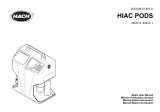
TABLE OF CONTENTS
1.0 DESCRIPTION................................................................................................................................................1
2.0 FYRITE INSPECTION BEFORE AND DURING TEST ..............................................................................1
2.1 Pre-Operational Check .......................................................................................................................1
2.2 FYRITE FLUID HANDLING PRECAUTIONS ...............................................................................2
3.0 BASIC FYRITE OPERATION PERCENT CO
2
AND 0
2
...............................................................................3
3.1 Determining CO
2
and O
2
FYRITE Fluid Strength .............................................................................7
3.2 Operating Precautions to Ensure Maximum Accuracy ......................................................................7
3.2.1 Draining Fluid Droplets .....................................................................................................8
3.3 FYRITE Temperature .........................................................................................................................8
3.3.1 Temperature of Gas Sample ...............................................................................................8
4.0 PRINCIPLE OF OPERATION ........................................................................................................................9
5.0 APPLICATION INFORMATION .................................................................................................................10
5.1 FYRITE Absorbing Fluid .................................................................................................................10
5.1.1 FYRITE Refi ll Fluid (Storage Life, etc.) .........................................................................10
5.2 FYRITE Operating Temperature Range ...........................................................................................11
5.3 Typical FYRITE Applications ..........................................................................................................11
5.4 CO
2
FYRITE Only Combustion Testing ..........................................................................................12
5.4.1 Percent CO
2
Shows Volume of Excess Air ......................................................................12
5.4.2 Too Much Excess Air Means Ineffi cient Combustion .....................................................13
5.4.3 What is Proper CO
2
Value? ..............................................................................................13
5.4.4 How To Calculate Combustion Effi ciency .......................................................................13
5.5 O
2
FYRITE Only Combustion Testing .............................................................................................13
5.5.1 Percent O
2
Shows Volume of Excess Combustion Air ....................................................13
5.5.2 Too Much Excess Air Means Ineffi cient Combustion .....................................................13
5.5.3 What is Proper O
2
Value? .................................................................................................14
5.5.4 Measuring O
2
in Addition to CO
2
...................................................................................14
5.5.5 Where is Percent CO
2
or O
2
Measured? ..........................................................................14
5.6 Background Gases Affecting FYRITE Readings .............................................................................16
5.7 General FYRITE Applications .........................................................................................................17
5.8 Altitude Correction Table .................................................................................................................18
6.0 FYRITE MAINTENANCE ..........................................................................................................................18
6.1 Increasing FYRITE Fluid To Proper Level ......................................................................................18
6.1.1 Decreasing FYRITE Fluid to Proper Level .....................................................................19
6.2 Checking FYRITE Fluid Strength ....................................................................................................19
6.2.1 CO
2
FYRITE Fluid Only .................................................................................................19
6.2.2 O
2
FYRITE Fluid Only ....................................................................................................21
6.3 Replacing FYRITE Fluid ................................................................................................................21
6.4 Inspection of FYRITE for Fluid Leakage ........................................................................................22
6.5 Cleaning FYRITE .............................................................................................................................24
6.6 Replacing FYRITE Plastic and Rubber Parts ...................................................................................24
6.7 Aspirator Bulb - Sampling Assembly ...............................................................................................26
6.8 Storing FYRITE and Refi ll Fluid .....................................................................................................26
6.9 Replacing Saturator Filter Packing Part #11-0121 ..........................................................................26
7.0 ILLUSTRATED PARTS LIST FYRITE CO
2
/O
2
..........................................................................................29
7.1 FYRITE Illustrated Parts ..................................................................................................................30
7.2 FYRITE Sampling Assemblies ........................................................................................................31

























